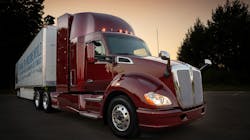CARB awards Port of LA $41 million to launch zero-emissions freight project
The California Air Resources Board (CARB) has preliminarily awarded $41 million dollars to the Port of Los Angeles (POLA) for the Zero Emission and Near Zero-Emission Freight Facilities (ZANZEFF) project. The total project cost for this initial phase is $82,568,872, with partners providing 50.2%, or $41,446,612 in match funding.
The Zero and Near Zero-Emission Freight Facilities project — proposed with support from Toyota, Kenworth, and Shell — provides a large-scale “shore to store” plan and a hydrogen fuel-cell-electric technology framework for freight facilities to structure operations for future goods movement. The initiative will help reduce emissions by 465 metric tons of Greenhouse Gas and 0.72 weighted tons of NOx, ROG and PM10. The Zero-Emission and Near Zero-Emission Freight Facilities project is part of California Climate Investments, a statewide initiative that puts billions of Cap-and-Trade dollars to work reducing greenhouse gas emissions, strengthening the economy and improving public health and the environment — particularly in disadvantaged communities.
“The Port of Los Angeles is showing the world that we don’t need to choose between environmental stewardship and economic growth — and this funding will help put zero emissions goods movement within our reach,” said Los Angeles Mayor Eric Garcetti. “I am grateful to CARB for this investment in America’s Port, as we continue to lead the drive toward a more sustainable future.”
“This matching grant from CARB’s California Climate Investments program is critically needed funding support to develop and commercialize the next generation of clean port equipment and drayage truck, as well as the infrastructure to support it,” said Port Executive Director Gene Seroka. “This grant funds a public-private collaboration that is representative of our commitment to being a ‘market maker’ through collaborative technology and fuel infrastructure development with industry leaders like Toyota, Kenworth and Shell.”
The Port of Los Angeles, which has become the global maritime leader with respect to zero emission and near-zero emission technology, will develop the project in several phases, ultimately encompassing initiatives in Southern California, the Central Coast Area, and Merced County. The initial phase is designed to kick-start the leap to a new class of goods movement vehicles, while reducing emissions in designated disadvantaged communities.
The project phases will include:
- Ten new zero-emissions hydrogen fuel-cell-electric Class 8 on-road trucks on the Kenworth T680 platform will be developed through a collaboration between Kenworth and Toyota to move cargo from the Los Angeles ports throughout the Los Angeles basin, as well as ultimately to inland locations such as Riverside County, the Port of Hueneme, and eventually to Merced. The trucks will be operated by Toyota Logistics Services (4), United Parcel Services (3), Total Transportation Services Inc. (2), and Southern Counties Express (1).
- Two new large capacity heavy-duty hydrogen fueling stations will be developed by Shell in Wilmington and Ontario, CA. The new stations will join three additional stations located at Toyota facilities around Los Angeles to form an integrated, five-station heavy-duty hydrogen fueling network. Together, they will provide multiple sources of hydrogen throughout the region, including over 1 ton of 100% renewable hydrogen per day at the heavy-duty station to be operated by Shell enabling, zero-emissions freight transport. Stations supplied by Air Liquide at Toyota Logistics Services in Long Beach and Toyota Technical Center in Gardena will serve as important research and development locations.
- Expanded use of zero-emissions technology in off-road and warehouse equipment, including the first two zero-emissions yard tractors to be operated at the Port of Hueneme, as well as the expanded use of zero-emissions forklifts at Toyota’s port warehouse.
“Toyota believes that zero-emissions fuel-cell-electric technology, and the scalability, throughput speed, and driving range advantages of its hydrogen fuel, has the potential to become the powertrain of the future – and the capabilities of fuel-cell-electric heavy trucks are a big reason why,” said Bob Carter, the Toyota Motor North America executive vice president. “We are proud to team with the Port of Los Angeles, Kenworth and Shell and the operating partners to explore the benefits of a true zero-emissions heavy-duty truck platform and to support the development of a heavy-duty hydrogen fueling network in California. These trucks add to our growing portfolio of fuel-cell-electric vehicles as we lead the industry in expanding electrification through the use of this advanced, versatile, and scalable zero-emissions technology.”
“This is an excellent opportunity for POLA, Kenworth and Toyota to work together to both explore and drive advanced zero emission technologies that will play a critical role in the clean trucks of the future,” said Mike Dozier, Kenworth general manager and PACCAR vice president.
“This award is another recognition that hydrogen is a promising zero-emission solution for the heavy duty transport sector,” said Matthew Tipper, Vice President New Fuels at Shell. “We appreciate greatly the support from the Californian authorities and the opportunity to work with the Port of Los Angeles, Kenworth and Toyota in the deployment of a clean alternative fuel for California. The “Shore to Store” plan enables us to broaden our hydrogen offer to include heavy-duty transport.”
The “Shore to Store” project complements the extensive zero-emissions technology that is already under development for testing at Los Angeles terminals through partnership with the California Energy Commission. These investments showcase a clear, at-scale vision of the zero-emissions supply chain of the future and provide a model for a zero-emissions movement of goods.
Review and input on project implementation will be provided by the National Renewable Energy Laboratory and the South Coast Air Quality Management District.
North America’s leading seaport by container volume and cargo value, the Port of Los Angeles facilitated $284 billion in trade during 2017. San Pedro Bay port complex operations and commerce facilitate one in nine jobs in the five-county Southern California region.
About the Author
Fleet Owner Staff
Our Editorial Team
Kevin Jones, Editorial Director, Commercial Vehicle Group
Cristina Commendatore, Executive Editor
Scott Achelpohl, Managing Editor
Josh Fisher, Senior Editor
Catharine Conway, Digital Editor
Eric Van Egeren, Art Director
